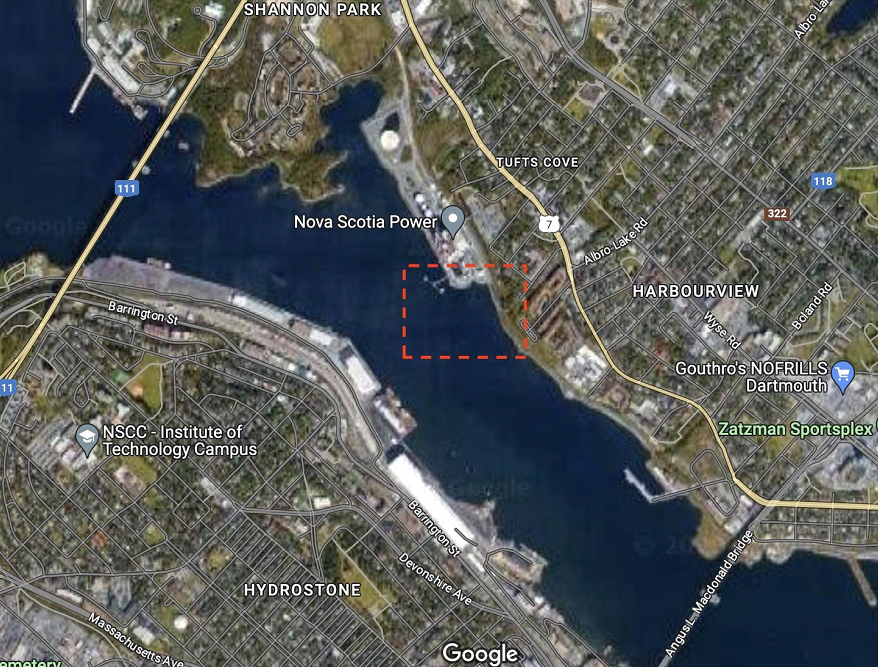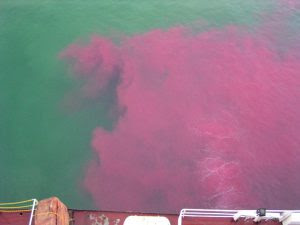Dalhousie Dye Tracer Study @ Tufts Cove
To Occur On: August 9-11, 2023
Residents and commuters in the vicinity of Nova Scotia Power's Tufts Cove Generation Station may observe a red/orange/purple tint to the waters to the south-west of the station in the morning of August 9, 10, or 11. This is a dye tracer added to the water in order to map how water moves away from the station’s cooling water outfall. The dye will dissipate quickly and will no longer be visible by the end of the day. There will also be small boat, drone and personnel activity in the region during this week, as researchers sample the dye. This bulletin explains the study and provides links to additional information.

Who: Dalhousie researchers in collaboration with Dartmouth-based Planetary Technologies.
What/Where: Dalhousie researchers will conduct a 1-day dye tracer addition from a cooling water outfall at Nova Scotia Power's Tufts Cove Generation Station.
When: Dye to be released, weather permitting, on August 9, 2023, with August 10 and 11 as alternate dates.
Why: To understand local circulation and mixing, and to test measurement/modeling techniques.
The dye tracer: Rhodamine WT, a fluorescent dye used extensively in natural water bodies, with well-known safety criteria (see example in Figure 2 and here).
How much dye will be added: The concentration entering Halifax Harbour will not exceed the maximum acceptable concentration quality standard (MAC-QS = 910 μg/L). The concentration will decrease rapidly away from the addition point and after the release ends.
What citizens may see: A distinct red/orange/purple colour will be visible in the vicinity of the release point (see example in Figure 2) for a number of hours following dye addition. Also, increased boat and drone activity in the vicinity as the Dalhousie team measures the spread of this plume.
Why Nova Scotia Power’s Tufts Cove Generation Station: The site was chosen due to the facility's cooling water outfall, located in Halifax Harbour.
Where to make enquiries or receive additional information: BBDyeTracer@dal.ca

More Information:
The Study: A Dye release from Nova Scotia Power's Tufts Cove Generation Station Outfall
Press Release
Please find our press release from August 1, 2023 here.
Background
Planetary Technologies (henceforth referred to as Planetary) are developing approaches to add an antacid (a mildly alkaline substance) to seawater in order to increase the ocean’s ability to take up CO₂ from the atmosphere (see planetarytech.com for details). This approach, called Ocean Alkalinity Enhancement or OAE, is one of several under consideration given the need to reach net zero greenhouse gas emissions by 2050. Initial field testing of Planetary’s concept and evaluation of its effectiveness is planned to take place at Nova Scotia Power's Tufts Cove Generation Station in Halifax Harbour, through a series of field trials. Bedford Basin / Halifax Harbour is an ideal site for such research and development because of its restricted water circulation, ease of access for measurement, and a high level of understanding of conditions in the Harbour built on extensive study by Bedford Institute of Oceanography and Dalhousie University over several decades. Conducting such research in the urban setting of the HRM also allows for public awareness and participation in the research.
Researchers from Dalhousie University’s Oceanography Department are working in collaboration with Planetary to develop approaches for verification of the ability of OAE to reduce atmospheric CO₂. As part of this effort, the Dalhousie researchers will conduct dye tracer releases in Halifax Harbour, using Rhodamine WT which will be introduced via an outfall at Nova Scotia Power's Tufts Cove Generation Station, in order to: a) characterize local water circulation and mixing, and b) test the ability to measure and model slightly elevated pH and altered levels of dissolved CO₂ associated with trial additions of antacid which are planned to take place later in 2023. These planned additions will likely use magnesium hydroxide (Mg(OH)₂) and/or magnesium oxide (MgO) as the alkalinity source and will be added through the same outfall, together with dye tracer.
The Tracer (Rhodamine WT)
The study will use Rhodamine WT: a fluorescent dye (see below) which has been used extensively, for almost 50 years, to study flow, transport, and mixing within natural water bodies including rivers, streams, lakes, groundwater, estuaries as well as the open ocean. For a recent example by researchers from Scripps Institute of Oceanography in California see here.
Rhodamine WT does not occur naturally in waters, is readily detectable, does not degrade rapidly and should follow the water’s movement: all qualities that make it useful as a tracer. Specific advantages of Rhodamine WT are that it can be measured continuously with sensors mounted on a variety of platforms, including unmanned aerial and underwater vehicles. This allows for rapid, continuous tracking of the spreading of the tracer in response to water movement. A key criterion underlying the widespread use of Rhodamine WT, including within drinking water systems and ecologically sensitive lakes and rivers, is its negligible ecotoxicity and toxicity to humans (see Douglas et al., 1983; Skjorling et al., 2015).
Based on previous studies, a “maximum acceptable concentration” quality standard (MAC-QS) of < 910 μg/L has been recommended for short-term, transient (“pulse-like”) exposure based on consideration of protection of the structure and function of aquatic ecosystems and avoidance of risk to humans.
The Study: A Dye release from Nova Scotia Power's Tufts Cove Generation Station Outfall
The study is planned to commence in the morning of August 9, weather permitting, with August 9 or 10 as alternate dates. Rhodamine WT dye will be introduced during an incoming tide by pumping dye into the discharge from the outfall at Nova Scotia Power's Tufts Cove Generation Station. The location of the outfall is shown in Figure 3. The discharge from the outfall is 190,000 liters/minute as reported by Nova Scotia Power, and a dilute solution of dye (max concentration of 8 g/L) will be added to this flow at a rate so that the concentration at the outfall never exceeds the safe (MAC-QS) limit of 910 μg/L. The dye will be added for a maximum of 3 hours.

The distribution and concentration of the dye will be tracked with a combination of measurements from a small boat, small autonomous underwater vehicles equipped with sensors as well as aerial drones for up to 2 days following the release.
The evolution of dye on August 9 was forecast on August 3 with our high-resolution circulation model of Halifax Harbour (see Animation 1). The model suggests that the tracer will be detectable by our sensors (>1 μg/L) only on the northwestern side of the Narrows and the Harbour on August 9 and 10. The dye will be flushed out and diluted to undetectable concentrations by August 11. The details of the dye movement depend on the weather conditions at the time of the release. The accuracy of the dye prediction thus depends on the accuracy of the weather forecast used to create our ocean forecast. One of the goals of the tracer study is to validate the model’s ability to make accurate predictions and check that our model adequately simulates the observed distribution and dispersion of the tracer, and eventually the antacid.
What can the public expect?
The dye will be clearly visible to the human eye when present at the surface in sufficiently high concentrations. The water in the vicinity of the outfall will have a distinct pink/purple/orange colour. Some examples of the appearance of Rhodamine WT during tracer studies in different environments are shown in Figure 4. We expect that the tracer will remain visible for a period of a few hours. There will be noticable activity in the vicinity of the dye release including small boats, aerial drones, and deployment of small AUVs. These AUVs look like small torpedoes (see Figure 5).
The public are very welcome to ask questions of the Dalhousie researchers before, during, and after the studies and send pictures. Enquiries can be addressed to BBDyeTracer@dal.ca. A limited number of observers can also be accommodated on prior request while ensuring that the logistics of dye sampling are not impacted. No modifications to use of the Harbour by large or small vessels is requested, although we ask that the public not interfere with the time-critical sampling from small boats and underwater drones.



Dalhousie Researchers
The study is led by Dalhousie researchers Dr. Dariia Atamanchuk, Dr. Douglas Wallace, and Dr. Katja Fennel and carried out with the help of many graduate students, postdoctoral fellows and Research Associates from the CREC.Ocean and MEMG labs.
Funding
The funding for the proposed dye release study, and interpretation of the results, comes from several peer-reviewed, public and philanthropic sources that have been applied for by Dalhousie researchers. These include two Alliance Grants of the Natural Sciences and Engineering Research Council (NSERC) and one major grant funded by an international, philanthropy-based organization (Carbon to Sea). The research is being coordinated closely with Planetary and they contribute cash support directly to one of the Alliance Grants as this was required by NSERC, the funding agency.
Chemical Description and Water quality standards for Rhodamine WT:
Rhodamine WT Material Safety Data Sheet: (http://docs.turnerdesigns.com/t2/doc/MSDS/050-0121.pdf).
Table 2 from Skjolding et al. (2015) listing acceptable concentration limits

References
Douglas, G. R., Grant, C. E., Bell, R. D. L., F. Salamone; John A. Heddle;, M., & R. Nestmann, E. (1983). Comparative mammalian in vitro and in vivo studies on the mutagenic activity of rhodamine WT. Mutation Research/Genetic Toxicology, 118(1-2), 117–125. doi:10.1016/0165-1218(83)90121-0
Available at : https://www.sci-hub.st/10.1016/0165-1218(83)90121-0
Skjolding, L. M., Dyhr, K. S., Köppl, C. J., McKnight, U. S., Bauer-Gottwein, P., Mayer, P., ... & Baun, A. (2021). Assessing the aquatic toxicity and environmental safety of tracer compounds Rhodamine B and Rhodamine WT. Water Research, 197, 117109. https://doi.org/10.1016/j.watres.2021.117109
Available at: https://www.sciencedirect.com/science/article/abs/pii/S0043135421003079?via%3Dihub